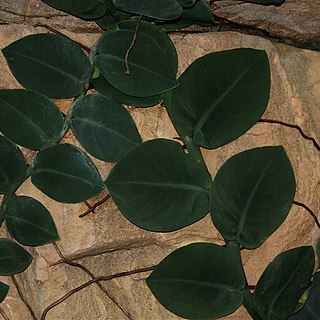Lianas, large; raphides numerous on stem and leaf; laticiferous ducts absent. Stems thick, creeping and climbing up trees or over rocks by aid of adhesive roots. Leaves distichous, petiolate; pulvinus short or long; petiole often adaxially grooved or canaliculate, sheath extending to pulvinus; leaf blade entire or divided, or perforate, thinly to rather thickly leathery, pinnately veined. Inflorescences terminal on leafy shoots, solitary or sometimes in a fascicle (synflorescence); as synflorescence develops axis sometimes reiterating and overtopping synflorescence such that inflorescence cluster is displaced and appears to be produced laterally (here termed "appearing axillary"). Spathe not constricted, initially inrolled and tubular, afterward spreading, firm, mostly early caducous, rarely marcescent. Stalk of spadix short or absent; spadix cylindric. Flowers many, bisexual or sometimes a few male, naked. Stamens 4; anthers much shorter than filaments, dehiscent by a slit. Ovary 1-or incompletely 2-loculed, 2-to many ovuled; ovules basal or parietal, 1-or 2-seriate; style broadly conic; stigma circular to linear, in latter case longitudinally inserted. Fruit with stylar plate sloughing away in groups or singularly to reveal ovary cavity with seeds embedded in pulp, many seeded. Seeds small, oblong to reniform.
Lianescent or epiphytic perennial herbs with tough fibrous stems; all parts of the plant (especially floral tissues) containing needle-like trichosclereids. Leaves numerous; petiole pulvinate apically, with sheath extending over most of petiole length; blade entire, oblong-ovate or lanceolate, often oblique (pinnatifid or perforated in many extra-African species); primary and secondary lateral veins parallel. Inflorescences 1–few, appearing with the leaves. Spathe boat-shaped, erect, soon withering and deciduous after flowering. Spadix cylindric, uniform in appearance. Flowers bisexual, lacking perigon, densely congested. Stamens 4; anthers dehiscing by oblique apical slits; connective very slender; filaments oblong, flattened. Pistil prismatic, truncate at apex; ovary unilocular, with 1–2(–3) intrusive parietal placentas and sometimes also base of locule bearing ovules; stigma sessile, linear to elliptic, ± prominent. Berries many-seeded. Seeds elongate, fusiform or flattened, straight or slightly curved; endosperm copious; embryo axile, straight or slightly curved.

